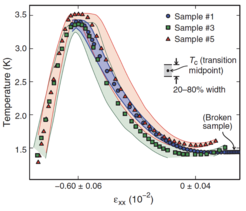Search for high temperature superconductivity using uniaxial pressure
A major new research direction led from our Institute over the past few years has been the use of uniaxial pressure to tune the properties of quantum materials.Uniaxial pressure itself is not new, but our piezoelectric-driven apparatus represents a completely different approach to previous designs of uniaxial pressure cells [1,2]. The new technique is highly controllable and precise, features that we have used in a series of precision experiments across a range of quantum materials [3-5]. However, it is also, in principle, capable of applying extremely large uniaxial pressures if used carefully, to the level that one is essentially changing the chemistry of the samples. As long as the elastic limit is not reached, these changes are completely reversible. In many materials of interest, the elastic limit is reached at lattice parameter changes of several per cent or more, and actually not very well known because it is difficult to reach it if the experiments are done properly.

These new capabilities raise the possibility of very substantially changing a material’s electronic structure. In favourable cases this has already been achieved, notably in the unconventional superconductor Sr2RuO4 where we raised the superconducting transition temperature Tc by a factor of 2.4 by accessing a van Hove singularity in the density of states [6]. In Sr2RuO4 this could be achieved by applying a relatively modest uniaxial pressure of order 1 GPa. A key question moving forward is whether we can successfully apply uniaxial pressures an order of magnitude larger than this, and whether we can then tune superconductivity in systems with much larger starting Tc to produce uniaxial-pressure-driven high temperature superconductivity.
This adventurous project will involve careful searches for candidate materials, focused ion beam fabrication of microscopic samples and pushing the boundaries of the precision with which those samples can be mounted in our uniaxial pressure apparatus. If this can be achieved, the rewards will be very high. Superconductivity is one of the most fascinating topics in all of physics, and finding new ways to control it would be a major breakthrough. The research also has natural links with development of uniaxial pressure apparatus for scanning tunneling microscopy in St Andrews, which would be available for atomically-resolved spectroscopic studies of the candidate materials. This project will be best suited to a scientifically ambitious student with an aptitude for experimental physics.












